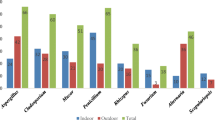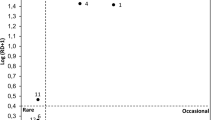Abstract
Aspergillus penicilloides Speg., Eurotium halophilicum Christensen et al. and other xerophilic fungi were isolated from house dust. The isolates of E. halophilicum are described and compared with the type strain of this species. A. penicilloides appeared to be rather common. The species concept of this species is broadened to accomodate some variable forms with different colony characters and conidiophore structures. The role of both species is discussed in connection with house-dust mites, house-dust allergy and skin diseases.
Similar content being viewed by others
References
Berrens, L., J. E. M. H. van Bronswijk, E. Young & A. G. van Dijk. 1975. A controlled study of allergen production in cultures of Dermatophagoides pteronyssinus. Acta Allergol. 30: 390–410.
Blaser, P. 1974/75. Taxonomische und physiologische Untersuchungen über die Gattung Eurotium Link ex. Fries. Sydowia Ann. Mycol. 28: 1–49.
Bronswijk, J. E. M. H. van & R. N. Sinha. 1973. Role of fungi in the survival of Dermatophagoides (Acarina: Pyroglyphidae) in house-dust environment. Environmental Entomol. 2: 142–145.
Christensen, C. M. & H. F. Kaufmann. 1974. Microflora. In: Storage of cereal grains and their products. Second edition. C. M. Christensen editor. American Association of Cereal Chemists Inc., St. Paul, Minnesota, USA, 158–192.
Christensen, C. M., G. C. Papavizas & C. R. Benjamin. 1959. A new halophilic species of. Eurotium. Mycologia 51:636–640.
Egorova, L. N. 1974. Micromycetes occurring in soils of coniferous forests of the Khabarovsk region. Mikol. Fitopatol. 8: 90–94.
Fonseca, O. J. de M. & C. da S. Lacaz. 1971. Study of fungal strains isolated from cases of keloidal blastomycosis (Lobo's disease). Taxonomy of the etiological agent. Rev. Inst. Med. trop. Sâo Paulo 13: 225–251.
Fragner, P., J. Vítovec, P. Vladík & Z. Záhor. 1973. Aspergillus penicilloides im solitären Lungenaspergillom bei einer Rehgeiss. Ceska Mycol. 27: 151–155.
Lustgraaf, B.v.d. 1977. Xerophilic fungi in mattress dust. Mykosen 20: 101–106.
Lustgraaf, B.v.d. & J. E. M. H. v. Bronswijk. 1977. Fungi living in house dust. Ann. Allergy 39: 152.
Raper, K. B, & D. I. Fennell. 1965. The genus Aspergillus, Williams & Wilkins Co., Baltimore, USA, 686 p.
Ridgway, R. 1912. Color standards and nomenclature. Published by the author, Washington DC, USA, 43p.
Storm van Leeuwen, W., Z. Bien, W. Kremer & H. Varekamp. 1925. Ueber die Bedeutung kleinsporiger Aspergillus Arten (Typus Aspergillus fumigatus) für die Aetiologie des Asthma Bronchiale. Zeitschr. Immunitätsforschung 44: 1–26.
Voorhorst, R., F. Th. M. Spieksma & H. Varekamp. 1969. House-dust atopy and the house-dust mite Dermatophagoides pteronyssinus. Stafleu, Leiden, The Netherlands, 159p.
Author information
Authors and Affiliations
Additional information
Supported by grant No. 230 of the Dutch Asthma Foundation.
Rights and permissions
About this article
Cite this article
Samson, R.A., Lustgraaf, B.v.d. Aspergillus penicilloides and Eurotium halophilicum in association with house-dust mites. Mycopathologia 64, 13–16 (1978). https://doi.org/10.1007/BF00443082
Issue Date:
DOI: https://doi.org/10.1007/BF00443082




